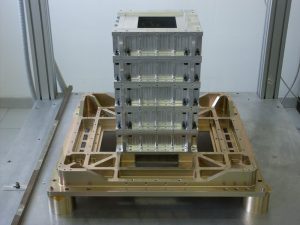 The Magnetic spectrometer is basically composed by a permanent magnet and a silicon tracker. The permanent magnet, which has a total mass of 115 Kg, is divided in five modules, each 81 mm high, interleaving six frames 8 mm high in which silicon sensors are placed. The magnetic material used is the sintered Nd-Fe-B with a large residual magnetic induction (1.3 T). The average field inside the magnet is 0.4 T, with a good homogeneity. The total height of the spectrometer is 445 mm, with an inner rectangular cavity of 161×131 mm2 corresponding to a geometrical factor of about 20.5 cm2sr. Six equidistant 300 μm thick silicon detector planes inserted inside the magnetic cavity constitute the Silicon Tracker that has a mass of 5 Kg and a power consumption of 61.7 W.
The Magnetic spectrometer is basically composed by a permanent magnet and a silicon tracker. The permanent magnet, which has a total mass of 115 Kg, is divided in five modules, each 81 mm high, interleaving six frames 8 mm high in which silicon sensors are placed. The magnetic material used is the sintered Nd-Fe-B with a large residual magnetic induction (1.3 T). The average field inside the magnet is 0.4 T, with a good homogeneity. The total height of the spectrometer is 445 mm, with an inner rectangular cavity of 161×131 mm2 corresponding to a geometrical factor of about 20.5 cm2sr. Six equidistant 300 μm thick silicon detector planes inserted inside the magnetic cavity constitute the Silicon Tracker that has a mass of 5 Kg and a power consumption of 61.7 W.
![]() Each plane is composed of 2 ladders, both made up of two double-sided, double-metal, AC coupled Silicon sensors. Each detector has a surface of 70.0×53.3 mm2, each side divided in 1024 strips, providing two independent impact coordinates on each plane. The implantation pitch is of 25 μm on the junction side, with a read-out pitch of 50 μm, and of 67 μm on the ohmic side. For the front-end electronics the VA1 chip is used.
Each plane is composed of 2 ladders, both made up of two double-sided, double-metal, AC coupled Silicon sensors. Each detector has a surface of 70.0×53.3 mm2, each side divided in 1024 strips, providing two independent impact coordinates on each plane. The implantation pitch is of 25 μm on the junction side, with a read-out pitch of 50 μm, and of 67 μm on the ohmic side. For the front-end electronics the VA1 chip is used.
The measured spatial resolution is 4 μm on the junction side, corresponding to the magnet bending side, and 15 μm for the ohmic (unbending) side. The efficiency for single plane is of 90% for 1 mip particle.The silicon tracker is able to measure the absolute charge of particle up to Z=4.The maximum counting rate of a single tracker counter is of the order of 105 s-1 and the dead time (reading and handling) introduced by the whole instrument is of 1.1 ms, that is the dead time of the Pamela instrument. The combined characteristics of the magnet and of the Silicon tracker will allow the measurement of the charge sign of the traversing charged particle and their momentum vector for rigidities (momentum per unit charge) up to a maximum Detectable Rigidity (MDR) of about 1 TV.
